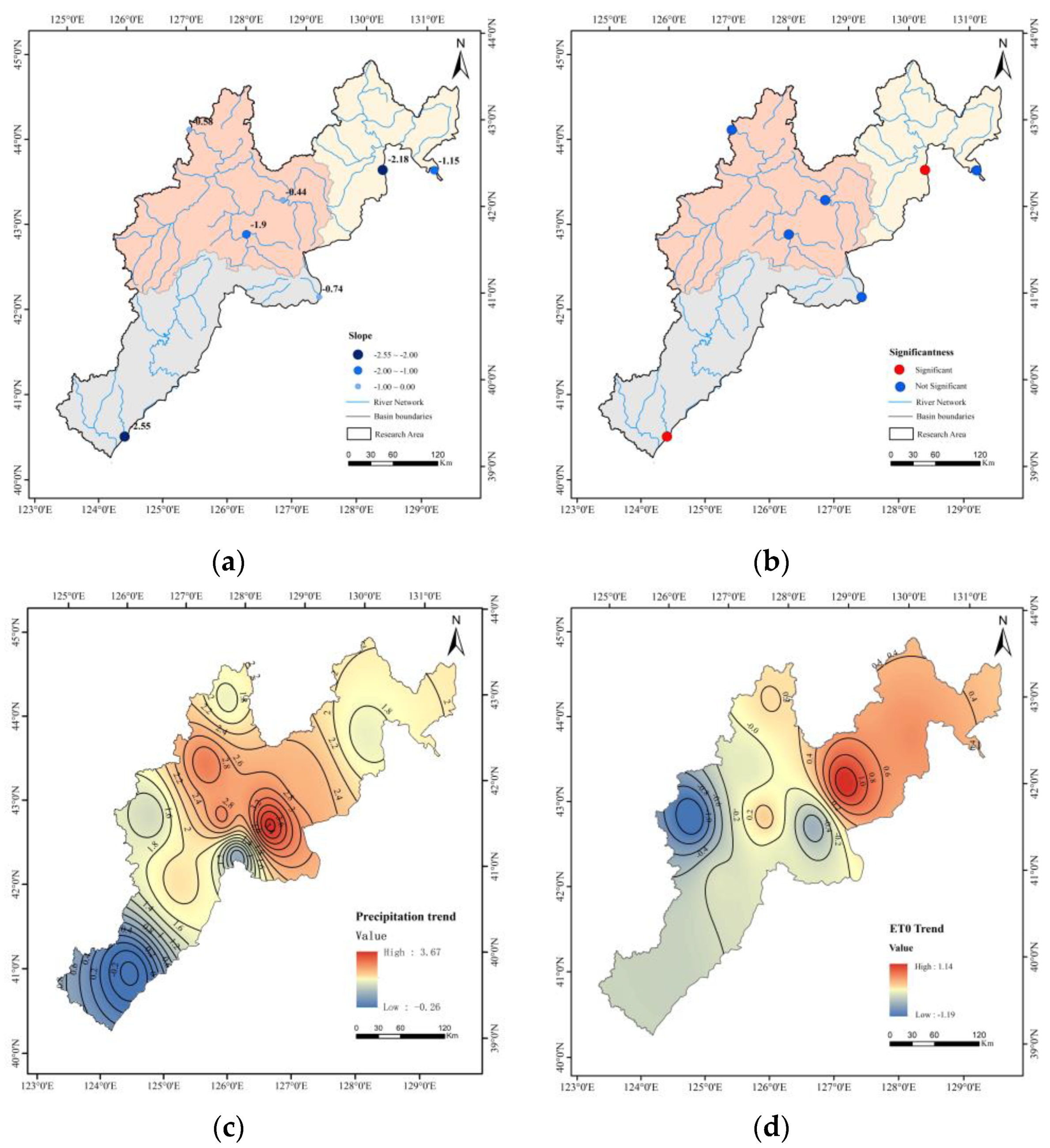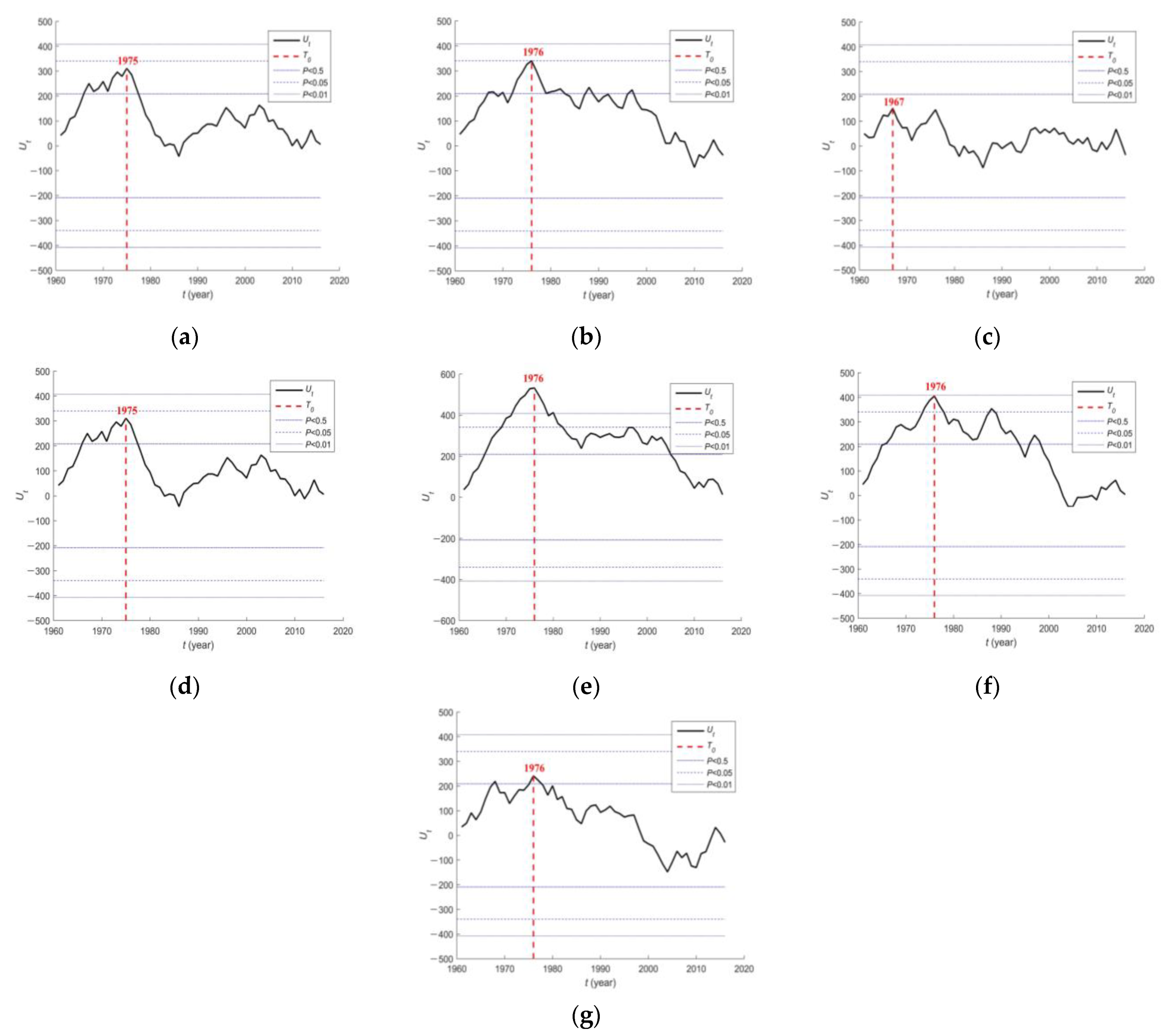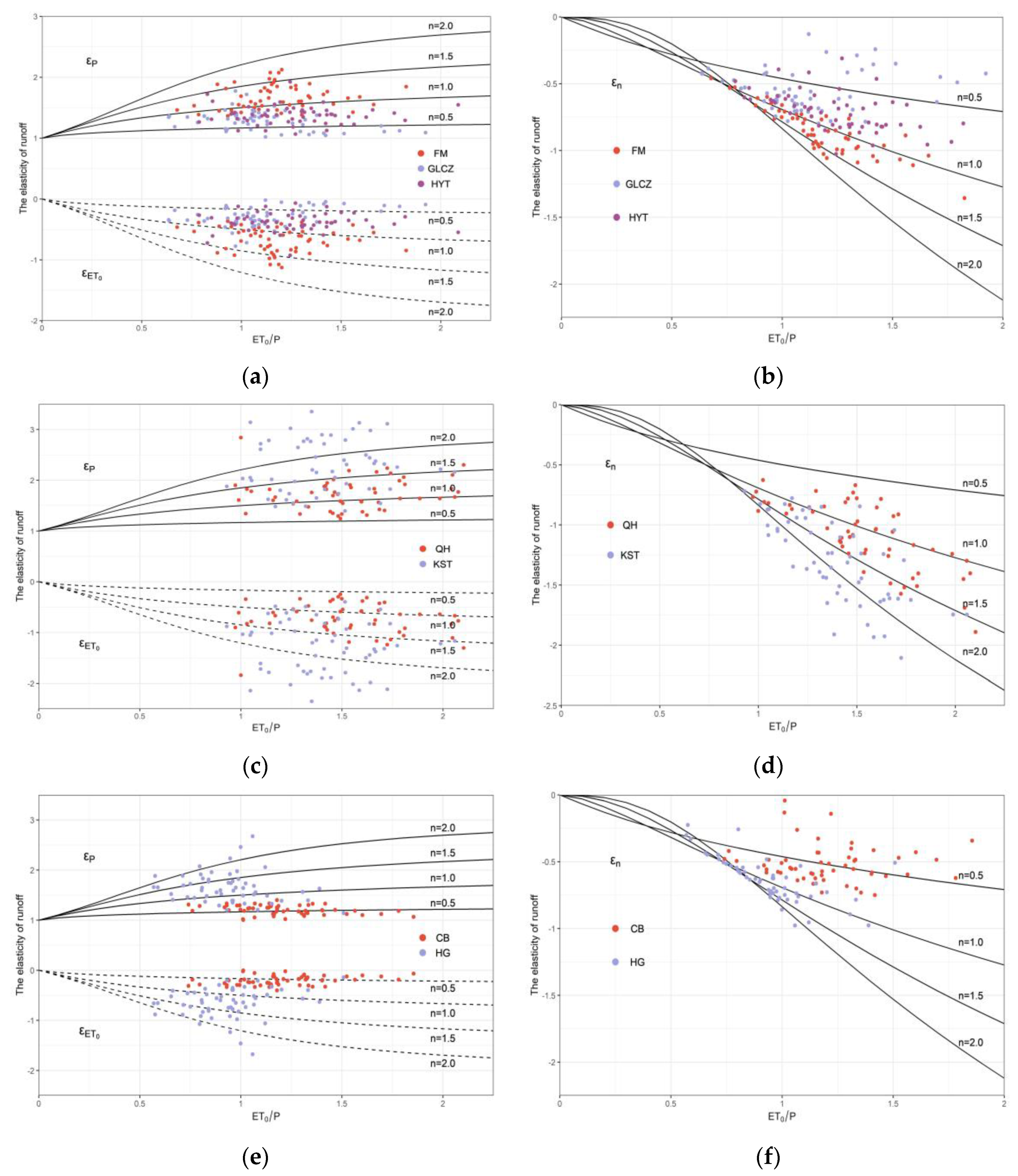Analyzing the Impact of Climate Change and Human Activities on Surface Runoff in the Changbai Mountain Area, Northeast China
Abstract
:1. Introduction
2. Materials and Methods
2.1. Study Area
2.2. Data
2.3. Methods
2.3.1. Sen’s Slope Estimator
2.3.2. Pettitt Mutation Point Test
2.3.3. Runoff Elasticity
2.3.4. Attribution Analysis of Runoff Changes
3. Results
3.1. Changes in Runoff and Climate Factors
3.2. Hydroclimatic Characteristics
3.3. Mutation Point of Annual Runoff
3.4. Runoff Elasticity
3.5. Attribution of Runoff Changes
4. Discussion
5. Conclusions
Author Contributions
Funding
Conflicts of Interest
References
- Allen, M.R.; Ingram, W.J. Constraints on future changes in climate and the hydrologic cycle. Nature 2002, 419, 228–232. [Google Scholar] [CrossRef] [PubMed]
- Amin, M.; Shaaban, A.; Ercan, A.; Ishida, K.; Kavvas, M.; Chen, Z.; Jang, S. Future climate change impact assessment of watershed scale hydrologic processes in Peninsular Malaysia by a regional climate model coupled with a physically-based hydrology modelo. Sci. Total. Environ. 2017, 575, 12–22. [Google Scholar] [CrossRef] [PubMed]
- Li, B.; Shi, X.; Lian, L.; Chen, Y.; Chen, Z.; Sun, X. Quantifying the effects of climate variability, direct and indirect land use change, and human activities on runoff. J. Hydrol. 2020, 584, 124684. [Google Scholar] [CrossRef]
- Xu, C.Y.; Chen, H.; Guo, S.L. Hydrological modeling in a changing environment: Issues and challenges. Water Resour. Res. 2013, 2, 85–95. [Google Scholar] [CrossRef]
- Fu, G.; Chen, S.; Liu, C.; Shepard, D. Hydro-Climatic Trends of the Yellow River Basin for the Last 50 Years. Clim. Chang. 2004, 65, 149–178. [Google Scholar] [CrossRef] [Green Version]
- Li, J.; Zhou, S. Quantifying the contribution of climate- and human-induced runoff decrease in the Luanhe river basin, China. J. Water Clim. Chang. 2015, 7, 430–442. [Google Scholar] [CrossRef]
- Zhang, H.; Huang, Q.; Gu, L.; Chen, K.; Yu, Q. Changes in the long-term hydrological regimes and the impacts of human activities in the main Wei River, China. Hydrol. Sci. J. 2016, 61, 1054–1068. [Google Scholar] [CrossRef]
- Das, J.; Nanduri, U.V. Assessment and evaluation of potential climate change impact on monsoon flows using machine learning technique over Wainganga River basin, India. Hydrol. Sci. J. 2018, 63, 1020–1046. [Google Scholar] [CrossRef] [Green Version]
- Huntington, T.G. Evidence for intensification of the global water cycle: Review and synthesis. J. Hydrol. 2006, 319, 83–95. [Google Scholar] [CrossRef]
- Xue, D.; Zhou, J.; Zhao, X.; Liu, C.; Wei, W.; Yang, X.; Li, Q.; Zhao, Y. Impacts of climate change and human activities on runoff change in a typical arid watershed, NW China. Ecol. Indic. 2021, 121, 107013. [Google Scholar] [CrossRef]
- Milly, P.C.D.; Dunne, K.A.; Vecchia, A.V. Global pattern of trends in streamflow and water availability in a changing climate. Nat. Cell Biol. 2005, 438, 347–350. [Google Scholar] [CrossRef] [PubMed]
- Chawla, I.; Mujumdar, P.P. Isolating the impacts of land use and climate change on streamflow. Hydrol. Earth Syst. Sci. 2015, 19, 3633–3651. [Google Scholar] [CrossRef] [Green Version]
- Wu, L.; Zhang, X.; Hao, F.; Wu, Y.; Li, C.; Xu, Y. Evaluating the contributions of climate change and human activities to runoff in typical semi-arid area, China. J. Hydrol. 2020, 590, 125555. [Google Scholar] [CrossRef]
- Li, F.; Zhang, G.; Xu, Y.J. Spatiotemporal variability of climate and streamflow in the Songhua River Basin, northeast China. J. Hydrol. 2014, 514, 53–64. [Google Scholar] [CrossRef]
- Wang, S.; Wang, Y.; Ran, L.; Su, T. Climatic and anthropogenic impacts on runoff changes in the Songhua River basin over the last 56years (1955–2010), Northeastern China. Catena 2015, 127, 258–269. [Google Scholar] [CrossRef]
- Kong, D.; Miao, C.; Wu, J.; Duan, Q. Impact assessment of climate change and human activities on net runoff in the Yellow River Basin from 1951 to 2012. Ecol. Eng. 2016, 91, 566–573. [Google Scholar] [CrossRef]
- Zhang, Y.; Guan, D.; Jin, C.; Wang, A.; Wu, J.; Yuan, F. Analysis of impacts of climate variability and human activity on streamflow for a river basin in northeast China. J. Hydrol. 2011, 410, 239–247. [Google Scholar] [CrossRef]
- Zhao, Y.; Zou, X.; Gao, J.; Xu, X.; Wang, C.; Tang, D.; Wang, T.; Wu, X. Quantifying the anthropogenic and climatic contri-butions to changes in water discharge and sediment load into the sea: A case study of the Yangtze River, China. Sci. Total Environ. 2015, 536, 803–812. [Google Scholar] [CrossRef] [PubMed]
- McVicar, T.R.; Li, L.; Van Niel, T.; Zhang, L.; Li, R.; Yang, Q.; Zhang, X.; Mu, X.; Wen, Z.; Liu, W.; et al. Developing a decision support tool for China’s re-vegetation program: Simulating regional impacts of afforestation on average annual streamflow in the Loess Plateau. For. Ecol. Manag. 2007, 251, 65–81. [Google Scholar] [CrossRef]
- Wagner, P.D.; Bhallamudi, S.M.; Narasimhan, B.; Kantakumar, L.N.; Sudheer, K.P.; Kumar, S.; Schneider, K.; Fiener, P. Dynamic integration of land use changes in a hydrologic assessment of a rapidly developing Indian catchmen. Sci. Total Environ. 2016, 539, 153–164. [Google Scholar] [CrossRef] [PubMed]
- Yonaba, R.; Biaou, A.C.; Kota, M.; Tazen, F.; Mounirou, L.A.; Zouré, C.O.; Queloz, P.; Karambiri, H.; Yacouba, H. A dynamic land use/land cover input helps in picturing the Sahelian paradox: Assessing variability and attribution of changes in surface runoff in a Sahelian watershed. Sci. Total Environ. 2020, 757, 143792. [Google Scholar] [CrossRef] [PubMed]
- Budyko, M.I. Climate and Life; Academic Press: New York, CA, USA, 1974. [Google Scholar]
- Sankarasubramanian, A.; Vogel, R.M.; Limbrunner, J.F. Climate elasticity of streamflow in the United States. Water Resour. Res. 2001, 37, 1771–1781. [Google Scholar] [CrossRef]
- Fu, G.; Charles, S.P.; Chiew, F.H.S. A two-parameter climate elasticity of streamflow index to assess climate change effects on annual streamflow. Water Resour. Res. 2007, 43, 2578–2584. [Google Scholar] [CrossRef]
- Roderick, M.L.; Farquhar, G.D. A simple framework for relating variations inrunoff to variations in climatic conditions and catchment properties. Water Resour. Res. 2011, 47, 667–671. [Google Scholar] [CrossRef]
- Choudhury, B. Evaluation of an empirical equation for annual evaporation using field observations and results from a biophysical model. J. Hydrol. 1999, 216, 99–110. [Google Scholar] [CrossRef]
- Yang, H.; Yang, D.; Lei, Z.; Sun, F. New analytical derivation of the mean annual water-energy balance equation. Water Resour. Res. 2008, 44, W03410. [Google Scholar] [CrossRef]
- Li, H.; Shi, C.; Zhang, Y.; Ning, T.; Sun, P.; Liu, X.; Ma, X.; Liu, W.; Collins, A. Using the Budyko hypothesis for detecting and attributing changes in runoff to climate and vegetation change in the soft sandstone area of the middle Yellow River basin, China. Sci. Total. Environ. 2020, 703, 135588. [Google Scholar] [CrossRef] [PubMed]
- Gbohoui, Y.P.; Paturel, J.-E.; Tazen, F.; Mounirou, L.A.; Yonaba, R.; Karambiri, H.; Yacouba, H. Impacts of climate and environmental changes on water resources: A multi-scale study based on Nakanbé nested watersheds in West African Sahel. J. Hydrol. Reg. Stud. 2021, 35, 100828. [Google Scholar] [CrossRef]
- Wu, J.; Miao, C.; Wang, Y.; Duan, Q.; Zhang, X. Contribution analysis of the long-term changes in seasonal runoff on the Loess Plateau, China, using eight Budyko-based methods. J. Hydrol. 2017, 545, 263–275. [Google Scholar] [CrossRef]
- Wu, J.; Miao, C.; Zhang, X.; Yang, T.; Duan, Q. Detecting the quantitative hydrological response to changes in climate and human activities. Sci. Total. Environ. 2017, 586, 328–337. [Google Scholar] [CrossRef] [PubMed]
- Gudmundsson, L.; Greve, P.; Seneviratne, S.I. The sensitivity of water availability to changes in the aridity index and other factors-A probabilistic analysis in the Budyko space. Geophys. Res. Lett. 2016, 43, 6985–6994. [Google Scholar] [CrossRef] [Green Version]
- Hasan, E.; Tarhule, A.; Kirstetter, P.-E.; Clark, R.; Hong, Y. Runoff sensitivity to climate change in the Nile River Basin. J. Hydrol. 2018, 561, 312–321. [Google Scholar] [CrossRef]
- Zhang, X.; Dong, Q.; Cheng, L.; Xia, J. A Budyko-based framework for quantifying the impacts of aridity index and other factors on annual runoff. J. Hydrol. 2019, 579, 124224. [Google Scholar] [CrossRef]
- Sinha, J.; Das, J.; Jha, S.; Goyal, M.K. Analysing model disparity in diagnosing the climatic and human stresses on runoff variability over India. J. Hydrol. 2020, 581, 124407. [Google Scholar] [CrossRef]
- Sen, P.K. Estimates of the regression coefficient based on Kendall’s tau. J. Am. Stat. Assoc. 1968, 63, 1379–1389. [Google Scholar] [CrossRef]
- Pettitt, A.N. A non-parametric approach to the change-point problem. Appl. Stat. 1979, 28, 126–135. [Google Scholar] [CrossRef]
- Fu, B. On the calculation of the evaporation from land surface (in Chinese). Sci. Atmos. Sin. 1981, 1, 23–31. [Google Scholar]
- Zhang, L.; Dawes, W.R.; Walker, G.R. Response of mean annual evapotranspiration to vegetation changes at catchment scale. Water Resour. Res. 2001, 37, 701–708. [Google Scholar] [CrossRef]
- Wang, D.B.; Tang, Y. A one-parameter Budyko model for water balance captures emergent behavior in Darwinian hy-drologic models. Geophys. Res. Lett. 2014, 41, 4569–4577. [Google Scholar] [CrossRef] [Green Version]
- Cao, X.L. Impact of Climate Change on Eco Hydrological Process of the Second Songhua River Basin. Ph.D. Thesis, Dalian University of Technology, Dalian, China, 2017. [Google Scholar]
- Dey, P.; Mishra, A. Separating the impacts of climate change and human activities on streamflow: A review of methodologies and critical assumptions. J. Hydrol. 2017, 548, 278–290. [Google Scholar] [CrossRef]





| Datasets | Type of Data | Spatial Resolution | Temporal Resolution | Period | Source |
|---|---|---|---|---|---|
| Meteorological observations | P, T, WS, SSD, VP, RH | Point data (10 stations) | Daily | 1960–2016 | National Meteorological Information Center of the China Meteorological Administration |
| Surface runoff observations | R | Point data (7 stations) | Yearly | 1960–2016 | Water Resources Commission of the Ministry of Water Resources |
| Equation recommended | ET0 | Point data (10 stations) | Daily | 1960–2016 | Estimated according to the Penman–Monteith equation |
| Basin | Station | Areas (km2) | P (mm a−1) | ET0 (mm a−1) | R (mm a−1) | ET0/P | R/P | n |
|---|---|---|---|---|---|---|---|---|
| SSRB 1 | Fengman | 42,500 | 723.57 | 816.24 | 311.85 | 1.13 | 0.42 | 1.11 |
| Gaolichengzi | 4728 | 779.67 | 828.04 | 504.64 | 1.06 | 0.66 | 0.65 | |
| Hanyangtun | 8532 | 654.64 | 796.57 | 369.90 | 1.22 | 0.56 | 0.77 | |
| TRB 2 | Quanhe | 31,800 | 558.13 | 834.65 | 209.01 | 1.50 | 0.37 | 1.07 |
| Kaishantun | 11,062 | 595.52 | 811.22 | 145.21 | 1.36 | 0.24 | 1.67 | |
| YRB 3 | Huanggou | 55,420 | 881.68 | 797.02 | 417.06 | 0.90 | 0.47 | 1.18 |
| Changbai | 2211 | 648.88 | 767.13 | 462.83 | 1.18 | 0.72 | 0.52 |
| Basin | Station | Data Period | Long-Term Mean Value | Elasticity | ||||||
|---|---|---|---|---|---|---|---|---|---|---|
| P (mm) | (mm) | R (mm) | n | |||||||
| SSRB | Fengman | 1960–1975 | 684.34 | 816.44 | 328.53 | 1.19 | 0.94 | 1.52 | −0.52 | −0.81 |
| 1976–2016 | 738.88 | 816.16 | 305.34 | 1.11 | 1.19 | 1.72 | −0.72 | −0.86 | ||
| Gaolichengzi | 1960–1975 | 714.01 | 838.63 | 566.43 | 1.18 | 0.42 | 1.13 | −0.13 | −0.41 | |
| 1976–2016 | 805.29 | 823.91 | 480.52 | 1.02 | 0.758 | 1.35 | −0.35 | −0.61 | ||
| Hanyangtun | 1960–1975 | 617.44 | 772.03 | 393.17 | 1.25 | 0.62 | 1.29 | −0.29 | −0.63 | |
| 1976–2016 | 669.16 | 806.14 | 360.81 | 1.21 | 0.80 | 1.42 | −0.42 | −0.75 | ||
| TRB | Quanhe | 1960–1975 | 527.32 | 827.39 | 253.09 | 1.57 | 0.81 | 1.48 | −0.48 | −0.94 |
| 1976–2016 | 570.16 | 837.49 | 191.81 | 1.47 | 1.19 | 1.83 | −0.83 | −1.15 | ||
| Kaishantun | 1960–1975 | 585.33 | 795.00 | 224.30 | 1.36 | 1.11 | 1.70 | −0.70 | −1.00 | |
| 1976–2016 | 599.49 | 817.55 | 114.35 | 1.36 | 2.02 | 2.63 | −1.63 | −1.42 | ||
| YRB | Huanggou | 1960–1975 | 864.53 | 807.36 | 502.05 | 0.93 | 0.83 | 1.39 | −0.39 | −0.58 |
| 1976–2016 | 888.37 | 792.99 | 383.89 | 0.89 | 1.37 | 1.80 | −0.80 | −0.66 | ||
| Changbai | 1960–1975 | 691.15 | 737.57 | 494.24 | 1.07 | 0.53 | 1.20 | −0.20 | −0.49 | |
| 1976–2016 | 632.39 | 778.67 | 450.57 | 1.23 | 0.51 | 1.20 | −0.20 | −0.52 | ||
| Basin | Station | Change from Base Period to Infact Period | Induced Runoff Change (mm) | Contribution to Runoff Change (%) | ||||||||
|---|---|---|---|---|---|---|---|---|---|---|---|---|
| SSRB | Fengman | −23.19 | 54.54 | −0.27 | 0.25 | 37.98 | 0.06 | −57.43 | 39.8 | 0.1 | 39.9 | 60.2 |
| Gaolichengzi | −85.91 | 91.29 | −14.71 | 0.34 | 74.87 | 2.4 | −152.75 | 32.6 | 1.0 | 33.6 | 66.4 | |
| Hanyangtun | −32.36 | 51.72 | 34.11 | 0.18 | 39.65 | −5.65 | −62.87 | 36.7 | 5.2 | 41.9 | 58.1 | |
| TRB | Quanhe | −61.28 | 42.84 | 10.1 | 0.39 | 26.6 | −1.66 | −79.39 | 24.7 | 1.6 | 26.3 | 73.7 |
| Kaishantun | −109.95 | 14.16 | 22.55 | 0.91 | 7.45 | −4.68 | −96.73 | 6.9 | 4.3 | 11.2 | 88.9 | |
| YRB | Huanggou | −118.16 | 23.84 | −14.37 | 0.54 | 17.93 | 4.44 | −124.39 | 12.2 | 3.0 | 15.2 | 84.8 |
| Changbai | −43.67 | −58.76 | 41.1 | −0.02 | −49.97 | −4.77 | 11.35 | 75.6 | 7.2 | 82.8 | 17.2 | |
Publisher’s Note: MDPI stays neutral with regard to jurisdictional claims in published maps and institutional affiliations. |
© 2021 by the authors. Licensee MDPI, Basel, Switzerland. This article is an open access article distributed under the terms and conditions of the Creative Commons Attribution (CC BY) license (https://creativecommons.org/licenses/by/4.0/).
Share and Cite
Zhang, S.; Liu, J.; Li, C.; Yu, F.; Jing, L.; Sun, J. Analyzing the Impact of Climate Change and Human Activities on Surface Runoff in the Changbai Mountain Area, Northeast China. Water 2021, 13, 3473. https://doi.org/10.3390/w13233473
Zhang S, Liu J, Li C, Yu F, Jing L, Sun J. Analyzing the Impact of Climate Change and Human Activities on Surface Runoff in the Changbai Mountain Area, Northeast China. Water. 2021; 13(23):3473. https://doi.org/10.3390/w13233473
Chicago/Turabian StyleZhang, Shanjun, Jia Liu, Chuanzhe Li, Fuliang Yu, Lanshu Jing, and Jiahui Sun. 2021. "Analyzing the Impact of Climate Change and Human Activities on Surface Runoff in the Changbai Mountain Area, Northeast China" Water 13, no. 23: 3473. https://doi.org/10.3390/w13233473
APA StyleZhang, S., Liu, J., Li, C., Yu, F., Jing, L., & Sun, J. (2021). Analyzing the Impact of Climate Change and Human Activities on Surface Runoff in the Changbai Mountain Area, Northeast China. Water, 13(23), 3473. https://doi.org/10.3390/w13233473







